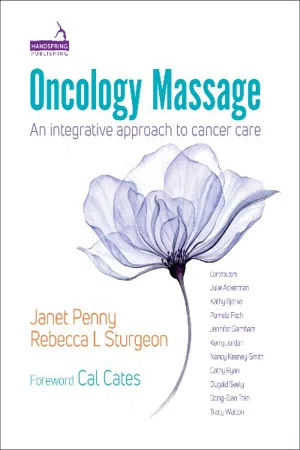
- 316 pages
- English
- ePUB (mobile friendly)
- Available on iOS & Android
About This Book
In Oncology Massage – an integrative approach to cancer care the authors have created a textbook which will provide both experienced and inexperienced therapists with a resource to expand their knowledge and understanding of working with people with cancer. Cancer occurrence and survivorship are now so common that every massage therapist will at some time work with clients who have been through cancer treatment. The short and long-term effects of biomedical cancer treatment require massage therapy adaptations to pressure, site, position and duration to provide safe and effective treatments. Informed massage therapists can support the body to promote overall wellness as well as identify the underlying secondary effects of cancer treatment that contribute to physical dysfunction.
Oncology Massage: An Integrative Approach to Cancer Care provides massage therapists with essential information for:
- Treatment planning based on the physiology of cancer and cancer treatments
- Critical, thoughtful treatment decision making
- Consideration of the psychosocial effects of cancer
- Enhancing therapist self-awareness and building a therapeutic relationship.
The information is presented in a clear and simple format with plentiful use of illustrations and information boxes which allows it to be used both as a learning tool for those new to the field of oncology massage and as a resource for quick referral when working with new patients.
The techniques of massage therapy change very little; it is the knowledge and understanding of their use that distinguishes a massage therapist. Oncology Massage is unusual in that it includes contributions not only from a range of experienced practitioners but also from people with cancer who have received massage during and after cancer treatment. This feedback from clients provides an invaluable addition to the understanding of how massage can be used as a safe and effective part of cancer care.
Frequently asked questions
Information
Table of contents
- Cover
- Title Page
- Copyright
- Contents
- Acknowledgments
- About the authors
- Foreword by Cal Cates
- Preface
- Introduction
- 1. Treatment considerations, and oncology massage through the life cycle
- 2. Integrative cancer care
- 3. Cancer and metastasis
- 4. Research
- 5. Introduction to oncology massage treatments
- 6. Surgery
- 7. Chemotherapy
- 8. Radiation therapy
- 9. Immunotherapy
- 10. Hormone therapies
- 11. The lymphatic system
- 12. Intake
- 13. Therapeutic relationship/The impact of massage on the massage therapist
- 14. Cancer and emotional health
- 15. Massage at the end of life
- 16. Oncology massage around the world
- Permissions
- Index